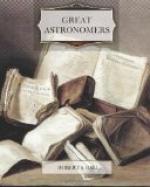Here, the young philosopher rapidly distanced his competitors in the various branches of ordinary school instruction. His superiority was, however, most conspicuous in mathematical studies, and, as a natural development of such tastes, we learn that by the time he had left school he had already made good progress in astronomy. At the age of seventeen he was entered as a commoner at Queen’s College, Oxford, and the reputation that he brought with him to the University may be inferred from the remark of the writer of “Athenae Oxonienses,” that Halley came to Oxford “with skill in Latin, Greek, and Hebrew, and such a knowledge of geometry as to make a complete dial.” Though his studies were thus of a somewhat multifarious nature, yet it is plain that from the first his most favourite pursuit was astronomy. His earliest efforts in practical observation were connected with an eclipse which he observed from his father’s house in Winchester Street. It also appears that he had studied theoretical branches of astronomy so far as to be conversant with the application of mathematics to somewhat abstruse problems.
Up to the time of Kepler, philosophers had assumed almost as an axiom that the heavenly bodies must revolve in circles and that the motion of the planet around the orbit which it described must be uniform. We have already seen how that great philosopher, after very persevering labour, succeeded in proving that the orbits of the planets were not circles, but that they were ellipses of small eccentricity. Kepler was, however, unable to shake himself free from the prevailing notion that the angular motion of the planet ought to be of a uniform character around some point. He had indeed proved that the motion round the focus of the ellipse in which the sun lies is not of this description. One of his most important discoveries even related to the fact that at some parts of its orbit a planet swings around the sun with greater angular velocity than at others. But it so happens that in elliptic tracks which differ but little from circles, as is the case with all the more important planetary orbits, the motion round the empty focus of the ellipse is very nearly uniform. It seemed natural to assume, that this was exactly the case, in which event each of the two foci of the ellipse would have had a special significance in relation to the movement of the planet. The youthful Halley, however, demonstrated that so far as the empty focus was concerned, the movement of the planet around it, though so nearly uniform, was still not exactly so, and at the age of nineteen, he published a treatise on the subject which at once placed him in the foremost rank amongst theoretical astronomers.
But Halley had no intention of being merely an astronomer with his pen. He longed to engage in the practical work of observing. He saw that the progress of exact astronomy must depend largely on the determination of the positions of the stars with all attainable accuracy. He accordingly determined to take up this branch of work, which had been so successfully initiated by Tycho Brahe.




